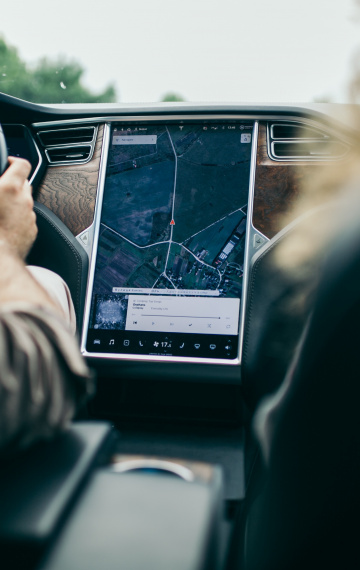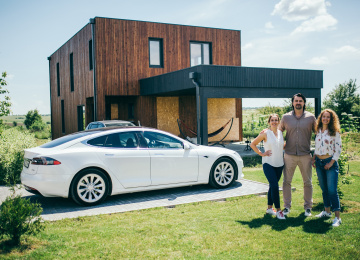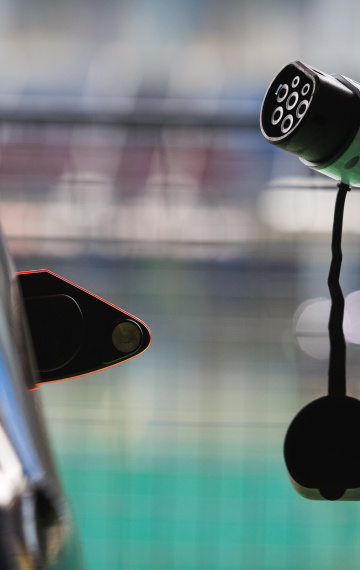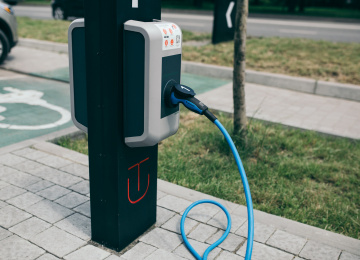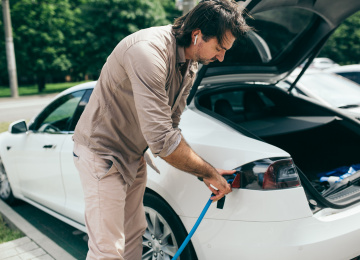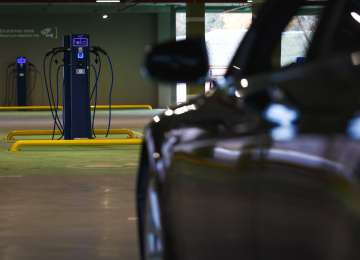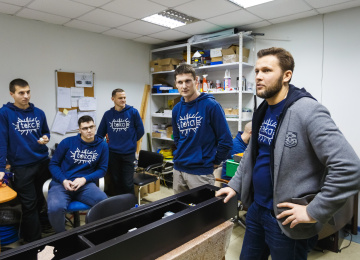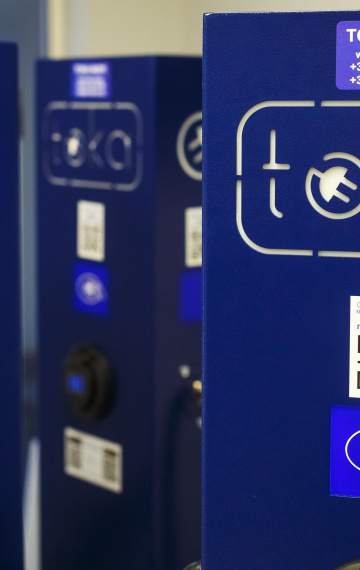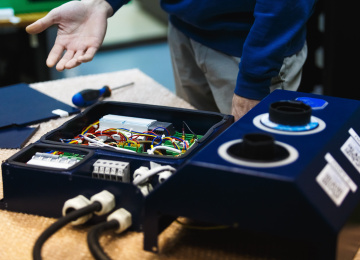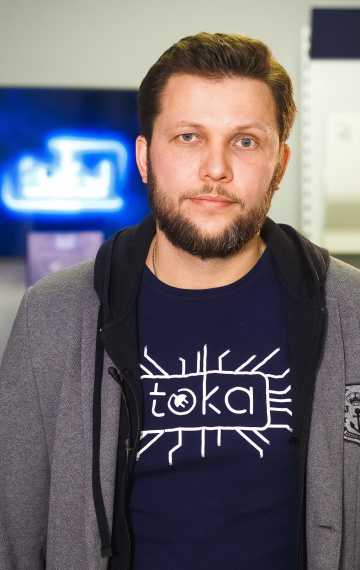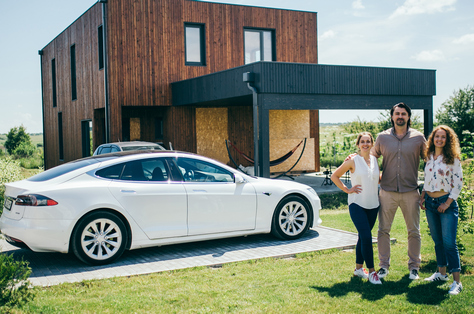
Less noise and exhaust on the roads, cheaper refills, and simpler maintenance are all advantages of electric cars. However, to be able to fully switch from regular cars, drivers need access to charging stations. There are businesses in Ukraine that strive to make the use of eco-friendly private transportation as common and comfortable as driving a car with a regular engine. This story is about two companies: Go To-U and TOKA. Go To-U is working on an international partnership platform that allows easy integration of a charging station into the work of any hotel or restaurant. TOKA is producing its own charging stations and building up the network.
The most environmentally friendly way to get around is by foot, or for long distances by bicycle, electric scooter, or electric public transportation. Environmentalists suggest using a taxi or carsharing for the purpose of decreasing the number of cars on roads and the load on the transport system. When none of the above options work, there is always an alternative in the form of a personal electric car. Compared to a car with a petrol or diesel engine, cars driven by an electric battery are currently the most efficient, comfortable, and accessible means of transportation decarbonisation available to drivers.
An electric future
The transport industry is responsible for 28% of CO2 emissions in the US. Road transport accounts for 20% of all CO2 emissions in Europe. Greenhouse gas emissions from using internal combustion engines (ICE), together with the risks of global warming and air pollution, is forcing humankind to look for alternative ways of getting around. Those are the demands of the Paris Agreement adopted in 2015 by 196 countries.
Considering electric cars a fully eco-friendly type of transportation is still under discussion, the reason being that greenhouse gas emissions during the production, refill, use, and utilisation of such cars do not equal zero. However, throughout the whole life cycle (in particular, due to the higher efficiency of an electric engine) electric cars produce at least 22% less CO2, and this number can go as high as 70-80% in countries with a decarbonised power generation. In Ukraine, 53% of produced electricity comes from nuclear power plants, but the higher the percentage of renewable (solar, wind) energy grows, the more environmentally friendly electric cars become.
Even though the electric engine was invented before the ICE, only in the 21st century electric cars earned well-deserved popularity. According to the BloombergNEF forecast, electric cars will account for 10% of global cars sales in 2025 and up to 58% in 2040.
There is an environmental standard in the European Union that regulates the contents of harmful elements in exhaust gasses, which increases the window of opportunity for electric cars. Currently, Europe is under the Euro 6 standard implemented in 2016. Since 2016 Ukraine has been under the Euro 5 emissions standard, and Euro 6 for new cars was postponed until 2025. Several European governments (including Norway, Sweden, the UK, and Denmark) declared plans to ban the sales of new diesel or petrol cars in the upcoming decades.
In Ukraine, the rate of electric car sales is rising. The first electric cars started appearing only in 2012 to 2013, but as of the end of 2020, over 20,000 electric cars were registered. At the same time, during January to September of 2020, there were 5,384 electric cars and 297,046 cars with ICE registered in Ukraine, so the ratio of electric cars to fuel-driven and hybrid ones is 2% to 98%. The distinction of the Ukrainian electric car market is that most of it consists of used foreign cars from the US and some other European countries.
Until the end of 2022, the Tax Code of Ukraine provides exemptions for the import of electric cars. There is no value-added tax (VAT) for electric cars until then. There is also a special excise tax that depends on the battery size. On top of this, starting in 2020, the Ministry of Internal Affairs (MIA) service centres are issuing green licence plates for electric cars and electric buses. The owners of green licence plates will have the right to park in specially designated spots (particularly to have constant access to charging stations). They will also be able to enjoy the benefits of such road signs as “For electric cars”, “Except for electric cars”, and “Electric car charging station”.
Another important aspect of stimulating the demand for electric cars is the development of a convenient infrastructure that will allow a car owner to make use of a charging station without obstructions. According to the IRD Group marketing agency, as of September 2020, there are 8,529 electric vehicle charging stations in Ukraine. This number increased by more than half throughout the year.
A big chunk of the Ukrainian market of charging stations is taken by a company from Kharkiv called Autoenterprise that produces charging stations, controls its own charging network, and also imports electric cars to Ukraine. The company director, Dmytro Nikonov, says that engineering development is the main direction of the company’s work.
Autoenterprise produces commercial charging stations (in particular, fast-charging ones) and complexes that can charge up to six cars simultaneously. Around a third of the charging systems are produced for the internal market, and the rest is for foreign companies. Autoenterprise works within the white label concept, meaning that they produce charging devices that are rebranded and used by companies all over the world.
The company has a few initiatives in the sharing economy industry. They established a ChargeSharing program which assists in creating one’s own network of charging stations and providing services of charging electric cars at one’s own rates. They also launched the AE CarSharing project — a per-minute rental of electric vehicles. On top of this, Autoenterprise works on developing its own electric vehicles: trolleybuses, tractors, and all-terrain vehicles (ATVs).
Go To-U: A partnership platform
The Ukrainian company Go To-U is developing an international partnership platform of charging stations for electric cars and a special app To-U where users have live access to availability for any given charging station and can reserve it for a needed time slot.
The idea of this startup appeared in 2013 and came to life in 2014 when co-founders of Go To-U Nazar Shymone-Davyda, Olena Artemenko and Lyubov Artemenko created Tesla Club Ukraine and brought the first car of this brand to Ukraine.
“When the Revolution of Dignity happened, we started thinking of how much electric cars, as a more comfortable and eco-friendly type of transportation, can positively influence not only Ukrainians as people but the country in general, and the whole infrastructure.”
Nazar Shymone-Davyda shares that he was first introduced to electric cars in 2007 when he lived in the US and worked at a Toyota dealership. At that time, electric cars were not yet produced for the general market.
“I kept an eye on this topic as it piqued my interest because it was something new and it can truly change our lives for the better. Electricity is used in all of our household appliances, but the cars practically got stuck in this sense by 80-100 years.”
Tesla Club consults clients about the purchase, use, and charge of new Tesla cars and also assists in ordering cars directly from the factory.
“The idea was that Tesla can draw attention to this type of transportation as a sort of anchor. We think that the adaptation of electric cars will have a powerful effect on the economy, the development of energy independence, and the development of innovations in the country.”
Nazar and Olena remember that at the time when they were bringing the first Tesla home from across Europe, they noticed that people in Ukraine have a higher level of perception of innovations. For example, at the Hungarian border, the officers took some time to ensure that the car truly had no petrol, while the officers at the Ukrainian border already recognised Tesla.
“There was a wow-effect during the first test drives. It was clear that these cars are the future. But more and more often we were told and began realising that this future may not happen in Ukraine, because, first of all, there are no good high-quality roads, and secondly, there is no infrastructure of charging stations. At that time, it was at a non-existent level.”
Ukraine is one of the leaders in Europe in the annual percentage increase of electric cars. Nazar Shymone-Davyda notices the market dynamics by the Go To-U hotline calls. Previously people who were interested in purchasing electric cars knew all about them, but in the past year or two, it is shifting from a niche segment into the mass market.
“We noticed that some people buy electric cars because they saw it somewhere, at their neighbours’. But they do not know anything about it, not a thing. So they come to a charging station and call us saying, ‘Well, I have a 220v socket but it doesn’t fit your outlet’. We explain, ‘You need such-and-such cable because this is a completely different technology’. And they are like, ‘Oh, okay, thank you, I just bought it yesterday’.”
Even if the whole of Ukraine switches to electric cars, electricity will not run out, the network will be able to handle it, and nothing will burn down. Nazar explains that when an electric car is connected to a regular outlet at night, it receives 2 kW per hour. So in 10 hours the car receives 20 kW of charge, and it is enough for more than a 100-kilometre run. Meanwhile, an average daily run in a city is around 50-60 kilometres.
“If we use this electricity at night when industries use it less and people are sleeping, we will level out the electricity consumption. It is a huge advantage for the country’s power system.”
As the infrastructure develops, the number of electric cars in Ukraine is rapidly growing, which causes lines at the charging stations. Since 2016, Nazar, Olena, and Lyubov have been working on the first prototypes of a Go To-U platform based on smart charging stations. These stations have access to the network and can be controlled from a server. In the same way, the businesses that installed the charging stations needed a way to see statistics and keep up with the feedback from users, which is why the Go To-U platform consists of two parts: a mobile app for the end user and an operating system that can be used by businesses to control the whole process.
“First and foremost, businesses receive loyal customers and are able to care for their needs and provide additional convenience. But they also need additional tools because a charging station is simply a part of equipment that needs to be controlled. So this tool practically connects businesses and the charging stations users.”
The project focuses on the comfort of the driver and passengers during a trip because the users of personal electric transportation want to be confident in the accessibility of charging stations whenever and wherever they need it, and to avoid wasting time at the time of charging. The developers of To-U consider the option of booking a charging station for the time needed very important. The station can also be booked ahead of time, as far as seven days in advance.
“When travelling in more developed countries, we noticed that the infrastructure is fragmented: different kinds of stations required different keys and passwords. There was no online information or ability to reserve a station. For example, you could be staying at a hotel that has a charger but you are not able to use it right away. Even at superchargers, all the slots are busy and it isn’t very clear when it will be free. We started creating our product based on these problems.”
The platform has thought through algorithms that regulate the process of reserving charging stations. The system automatically calculates the amount of time needed to reach the station and will offer reservations based on that time.
“If we do not drive towards the charger during 15 minutes, the charger becomes available for all users again, and we will be warned about it. If we see that we are running a little late, we can edit the reservation on the way to make sure it is available for us.”
The Go To-U platform provides a way to integrate a charging station into the work of any hotel, restaurant, store, or entertainment centre and to add this station to the network. This way, drivers can charge their cars and simultaneously have a good time, and businesses have a way to attract environmentally conscious clients and increase loyalty to their services.
Depending on a partnership program, a business can make their charging station public and free, only available for customers, or available to anyone for a set price per charge.
“Mostly, we explain that it is more interesting for a business to have the charging station available for customers for free. It is practically the same as treating a customer with a free cup of coffee. And of course, we see many situations when the stations are not always used by customers only. We have a different tool that provides a solution for this issue. Basically, the chargers can be free for customers, and everyone else would need to pay for them.”
In general, there are two main types of charging stations: with direct and alternating current. Chargers with direct current are fairly large in size and much more expensive to install, but they are also much faster at charging cars, which makes them most relevant on highways. Charging stations with alternating current are cheaper to install and slower at charging, which makes them more suitable for shopping malls, restaurants, or hotels, where a customer spends more time. In any case, the cost of charging an electric car is always cheaper than refilling a regular car with petrol.
“Compared to petrol, charging an electric car is exactly 10 times cheaper. Take away one zero, and that will be the cost of going 100 kilometres on an electric car. If we are talking about the high-speed chargers on highways, for example, then the cost is the same as refilling a natural gas car at a gas station. So it makes it twice as cheap as petrol.”
The company Go To-U received a grant as part of the Climate Innovation Vouchers project implemented by NGO Greencubator with support from the European Bank for Reconstruction and Development and the European Union. Thanks to the voucher, the developers improved the functionality of the mobile app. In particular, the owner’s profile was created to collect and track statistics.
In Ukraine, the platform currently has 80 locations. Go To-U also cooperates with foreign partners that install charging stations and through that receive the operating system for developing it for their own markets. The Go To-U team has recently signed a contract with a big roaming platform Hubject that will provide the ability to route the way to 250,000 charging stations in 43 countries.
“We have the most users in Ukraine. Additionally, we directly work with Portugal, Romania, Poland, the USA, the UK, and Thailand. We are preparing to launch in a few more countries in Asia in the first half of 2021. We count users through active app sessions, which go up to 20,000 per month. Our goal is to turn our app into a global platform for an infrastructure of charging stations in each country.”
Go To-U does not produce their own stations but installs KEBA charging stations that are made in Austria. When choosing chargers, the company pays close attention to certifications from electric car producers and compliance with safety standards. The platform shows charging stations of only globally known manufacturers under the condition that they are properly installed and have a ground connection. Nazar says that he had a personal negative experience with charging an electric car that happened before developing Go To-U:
“One time we were charging in Kyiv at a charging station that, at that time, was practically handmade, and in our car one out of three fuses burned out. So the car was charging at a ⅓ slower speed. We went to a service centre, and they fixed it as a warranty claim. But they warned us that they see where we are charging. So the car records everything and sees what the actual problem was.”
There is a popular opinion that an electric car is purchased first and foremost for economic purposes. But Nazar is convinced that it is a myth because a person who wants to save money would rather buy a regular used car with foreign registration. This shows that electric car fans are people who see the difference in quality and comfort. The economic savings during use is simply a huge bonus to this comfort.
“An electric car is much more convenient, quiet, and comfortable. It does not require maintenance as such, because there is no need to change oil, filters, and many other parts present in a regular car. All that is needed is to switch to winter tires in winter and summer ones in summer — that’s it. Very rarely does anything break, there are far fewer parts that move. A person that switched to an electric car will most likely never return to using a regular one.”
TOKA: Developing charging stations
TOKA is a Ukrainian company that strives to make the use of an electric car as comfortable as a car with an ICE. They develop their own charging stations and supply the Ukrainian market with stations from foreign manufacturers, build up the network of electric charging systems, and, with the help of their own cloud platform and mobile app, act as a charging point operator by controlling the process of charging.
Stefan Blagovisnii founded this network in 2015. He worked in the automotive business before as well and purchased first the Nissan Leaf and later a Tesla for his rental company fleet.
“It was interesting because we were like early adopters of something new. Afterwards you start thinking, what is the purpose of it? And when you see everything that is happening with the environment, you start understanding that you have to be responsible for what you do. The change in technology generations happens with your help. I would really want to be a part of this change.”
In the process of renting the first electric cars, Stefan saw that customers without a private house do not have a way to recharge, and there was no Ukrainian product for this at the time. So he decided to buy a ready-to-go foreign solution for charging electric cars and to install stations in big cities (for example, Kyiv and Odesa).
“When we came to a foreign company they asked, ‘What size is your market?’ We said, ‘We already have 420 cars’. They laughed out loud and said that this market does not interest them and that building a network and especially software would be too expensive.”
Then, the TOKA team decided to take a different route. They began installing public charging devices from a foreign manufacturer free of charge for customers. At the same time, they studied the structure of these devices and worked on their own hardware and software, which took two years. In 2017, the first TOKA charging devices appeared, and they have already begun to be monetised.
“When we added a fee for charging, the volume of charging decreased by 30 times. After that it grew by 1.5% per month from almost zero. Today, there are over 14,000 customers in the TOKA network.”
Stefan thinks that the electric car market has been changing dynamically in recent years. There are transportation and delivery services that use electric cars as their main type of vehicle. It is profitable to use them with a commercial purpose, in particular due to compensations and benefits set for purchasing electric cars:
“(Due to compensation) the cost of an electric car almost equals a similar car with an ICE, so it is no longer more expensive, but it ends up being much cheaper to use. Ukraine has very low prices per kW and expensive petrol. Owning such a car is also cheaper as there is no required maintenance, petrol, or oil materials to replace, and so on.”
As of 2020, the network has a few hundred charging stations in almost all regions of Ukraine, with most of them located in Kyiv and Odesa. TOKA created commercial and home models of electric chargers with alternating current from scratch, and the company partially uses components made in Ukraine. The company also allows the possibility of connecting a different charging device from a different brand name to their network.
“For the most convenient use of the charger services, you need a mobile app where you can turn on GPS and see which charging station will be more convenient to use. You can also see its status, so you’re able to plan your time accordingly.”
In 2018, TOKA presented a Smart Grid Solution system that uses smart technology to balance the electricity load in apartment buildings. This system can be integrated into both old and new buildings and should create charging spots for electric cars in the parking zone available to residents and allow using excess electricity at nighttime. Such a project offers a more budget-friendly setup of electric chargers in buildings and makes electric cars more appealing to Ukrainians.
“The idea is to take excess power and effectively provide it to electric cars. At the same time, the house or apartment building is more prioritised in using the excess power. So if someone turns on an electric kettle, the parking lot needs to let this power go.”
Developers were able to install this system at the Boryspil airport and a new residential complex in Kyiv.
“If we have 200 kW of backup power, it makes for 10 chargings 20 kW each, so there are only 10 happy electric car owners. But with this system, more cars can be charged at the same time, but depending on the load the speed will vary.”
A three-storey Zoo parking structure was built on the territory of the capital zoo, equipped with an electric car hub consisting of seven charging stations (with three ports in each one). These charging devices are also able to reasonably share the free power.
“We use the maximum power that we freely receive from the zoo and split it amongst the cars depending on the need.”
TOKA also participated in the Climate Innovation Vouchers project by NGO Greencubator. With its help, developers created a new charging station frame that uses 20 kg less of iron per charger. It lowers both the production cost and the carbon footprint from producing the stations.
The main innovation that was implemented thanks to the vouchers was the development of the Open Charge Point Protocol (OCPP), which allows clients from other networks to use TOKA stations and lets TOKA clients use similar infrastructure in other countries. Such a system allows Ukrainian owners of electric cars to go abroad comfortably and makes Ukraine friendlier towards guests driving electric cars.
“There was a need to make our equipment and software OCPP certified. This protocol appeared a bit later after we began building our own product, and we needed to redo everything to make sure it would be OCPP approved.”
TOKA charging stations have a Ukrainian certificate of compliance and a certification according to the EU standards. They are not planning to receive a certification of electric car manufacturers yet because it would require a higher production volume.
“In my opinion, a client needs to see how the station is used. If it is active, most likely everything is okay. It is not profitable for us as a network to have problems with safety, because each case could have huge negative consequences. It won’t do any good to cut corners. Public devices have to comply with requirements because the responsibility falls on the network and an establishment, and they control each other.”
TOKA plans to continue increasing the volume of charging station production to build up the number of chargers in the network and to link in roaming with other operators on the Ukrainian market.
“Roaming for electric cars is the same as roaming for cell phones. So today you are only limited by the app that has one network. But this way, one app will allow charging at any station, so this is an improvement for the client.”
Stefan thinks that the task of the government is to create conditions for developing the electric car market. For example, charging stations on a highway are necessary for car drivers, but businesses are not financially interested in placing them at such locations. At the same time, switching to electric cars is necessary; otherwise, our country risks “becoming a scrapyard for old European cars with ICE”.
“I see a philosophy of freedom and autonomy in an electric car. Even though it is tied to an outlet, you can connect to any outlet. You do not need an oil refinery.”

